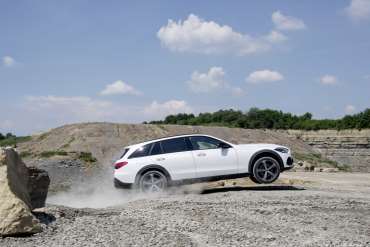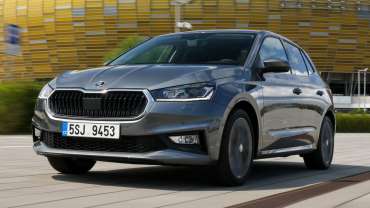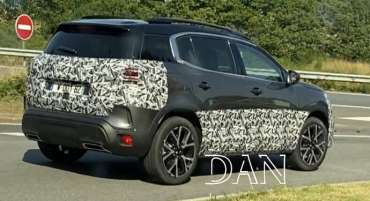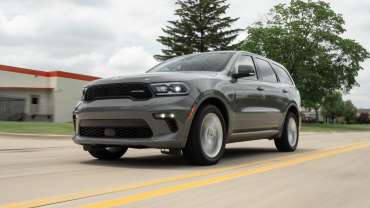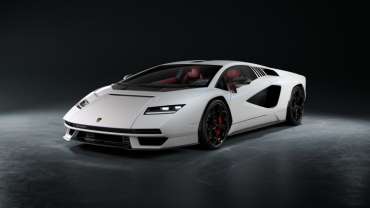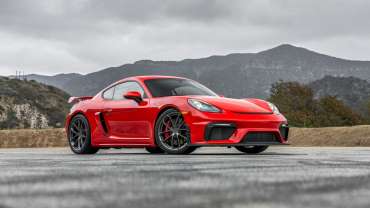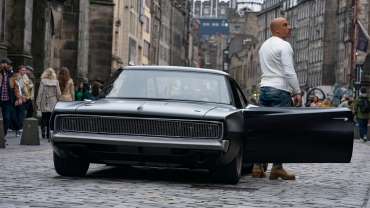
Worldcarblog.com
New Mercedes C-Class gets all-terrain version
The new version on offer is based on the C-Class station wagon, and features four-wheel drive, several design changes, two additional driving modes and improved off-road capabilities.
The Mercedes C-Class All-Terrain has a higher ground clearance of 40 mm compared to the standard station wagon version, larger wheels and is the first model with the All-Terrain designation since the E-Class received this 2017 version.
The German company claims that the car is now ready for worse roads and trips off the asphalt, because the suspension is set to cope with all the challenges of off-road driving. Gasoline and diesel engines are also available with mild hybrid technology that allows for lower energy recovery consumption.
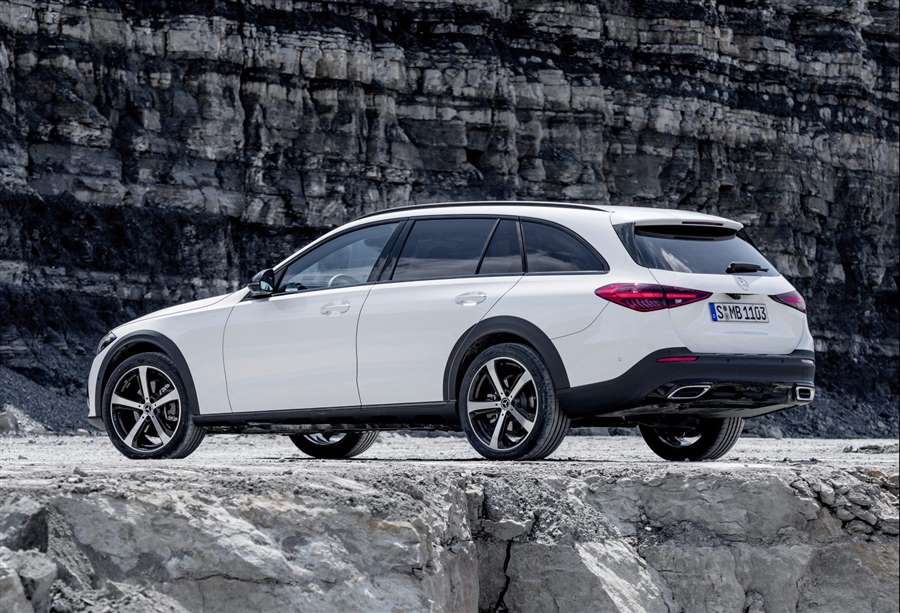
These are the same engines that power the C-Class station wagon, but performance and consumption information for the All-Terrain version have not yet been announced.
Two additional driving modes are called Offroad and Offroad +. The first allows easier passage through terrain such as sand, mud and gravel, while the Offroad + is designed for harder and steeper ascents, and there is also a system that controls the speed when descending a slope.
The Mercedes C-Class All-Terrain comes standard with LED lights, and 17- to 19-inch wheels will be available. This model also has several design changes, such as a chrome radiator grille, modified bumpers and chassis protection. There are also additional chrome details on the exterior of the car that distinguish this version from the standard station wagon.
Inside the cabin, the All-Terrain is fitted as standard in the Avantgarde specification, with three brown and black color schemes. The screen of the multimedia system also has additional options related to off-road driving, as it shows the angle of inclination together with the geographical coordinates and the compass.
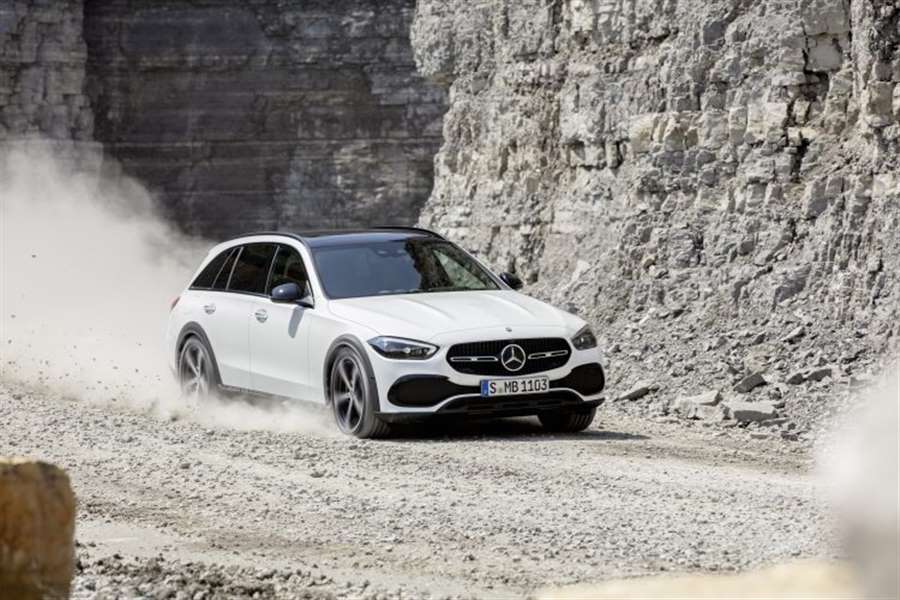
The price for this model has not been announced yet, but it is expected that it will be necessary to set aside a few thousand euros more compared to the standard C-Class station wagon.
New Skoda Fabia 2021 review
The new Skoda Fabia has all the credentials to challenge the very best in the supermini class
The new Skoda Fabia shows lots of promise on this early drive; it’s comfortable, spacious, neatly finished and packed with lots of clever features and useful technology. Pricing - particularly those crucial monthly finance rates - will determine its overall standing in the class, but on raw merit it feels every bit the serious rival for the Clio, Fiesta and i20. Be careful on engine choice, though, if you’re planning regular travel with the car fully laden.
The Skoda Fabia is a huge car for the Czech manufacturer - and never more than with the all-new fourth generation. The popular supermini still has to provide a slightly better-value, more roomy alternative to the likes of the Renault Clio and Ford Fiesta. But it also has to be cheap enough at its entry point to appeal to customers of the now-discontinued Citigo city car. And due course it’ll also need to satisfy buyers of the Scala, Skoda’s compact family car, which won’t get a successor.
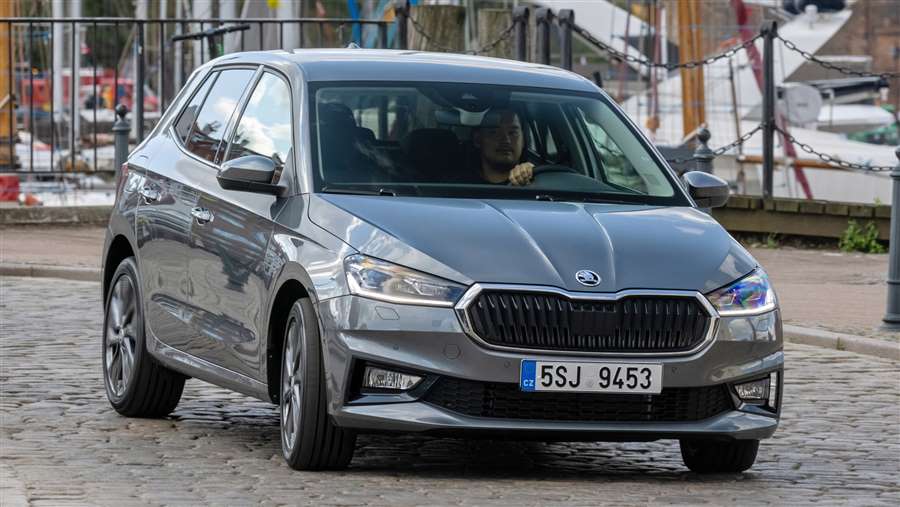
What that all means, in short, is that this Fabia has to be bigger, better and more refined than before, including the sort of technology that customers in the class above expect, while not really raising its price much beyond current levels. No pressure, then Still, Skoda has an ace card up its sleeve, because the outgoing Mk3 Fabia was the last VW Group supermini to be based on the old PQ platform. The new fourth-generation Fabia switches onto the MQB A0 platform, instantly giving Skoda’s designers and engineers more freedom to broaden the Fabia’s remit.
The result is a substantial growth in length - by more than 11cm, in fact. And almost all of that goes into the wheelbase, in a bid to improve rear cabin space. The boot capacity increases too, mind; it’s up by 50 litres, to a Golf-rivalling 380 litres, although this is still a little down on what you’ll find in our class favourite, the Clio.
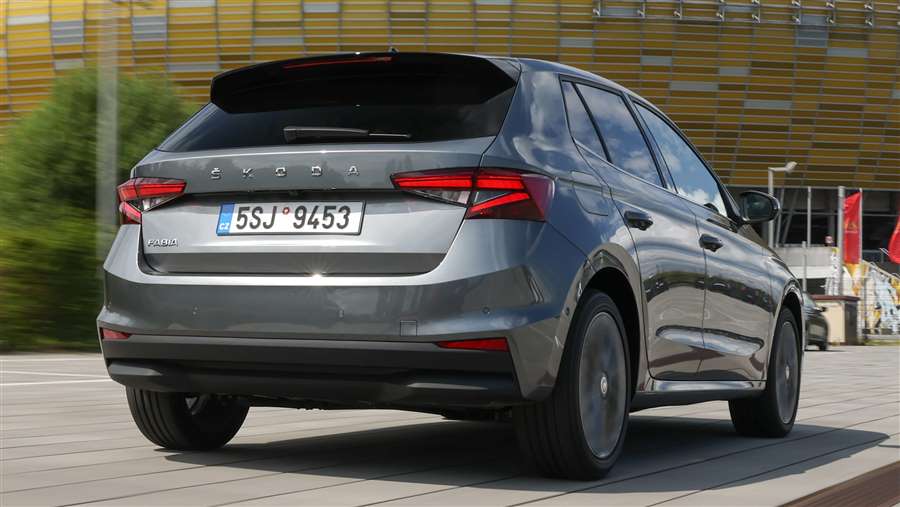
Under the skin, Skoda has resisted the temptation to spend money developing mild-hybrid powertrains (now offered in the Hyundai i20 as well as the Fiesta). Instead the engine line-up looks rather familiar, with a pair of normally aspirated MPI three-cylinder motors, producing 64bhp and 79bhp and both delivering 0-62mph times worryingly beyond 15 seconds, and then two more TSI turbocharged three-pots, with 94bhp and 109bhp.
What we’re driving today is pretty much the likely sweet spot of the UK Fabia range: the TSI 1.0-litre engines in both states of tune, and both with manual gearboxes - a five-speed in the 94bhp, a six-speed in the 108bhp. Skoda sources suggest the more modest of these configurations is likely to be the best seller in the UK, although the split may be closer if the Fabia does succeed at pulling in family car customers.
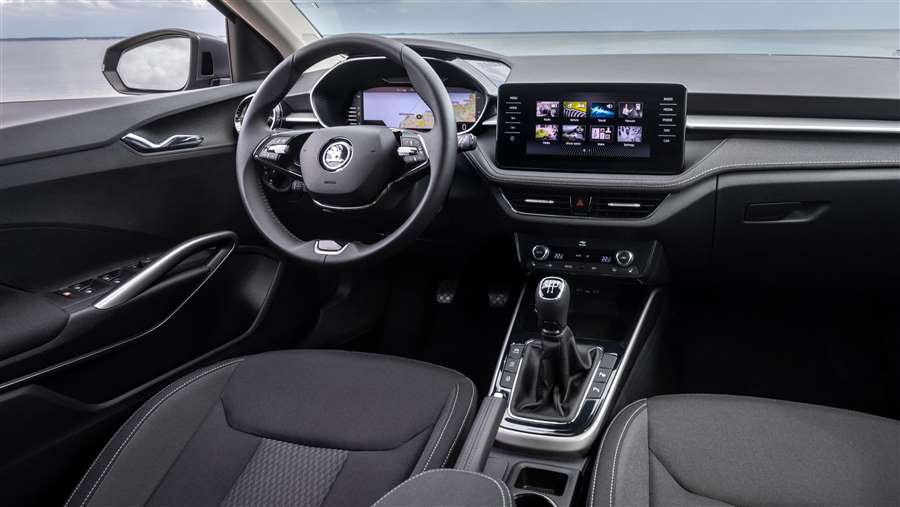
Entry-level cars will stick with conventional dials but many Fabias will get a 10.25-inch digital instrument panel that’s crisp and clear. The core of the UK range will have an eight-inch infotainment system - again, straightforward to use and spared the dubious honour of controlling heating and ventilation, because you get regular switches for that. A larger 9.25-inch set-up will also be available.
There are plenty of big-car features on offer, depending on trim level and how much you’re prepared to spend on options. Dual-zone climate control is on the list, along with heating on the windscreen and steering wheel, up to five USB-C ports and wireless smartphone charging. Skoda claims the car features a record 42 of its ‘Simply Clever’ touches too; the Fabia now gets Skoda’s trademark umbrella in the door armrest, plus a neat pen holder at the base of the dashboard and a removable central storage box for the back-seat passengers.
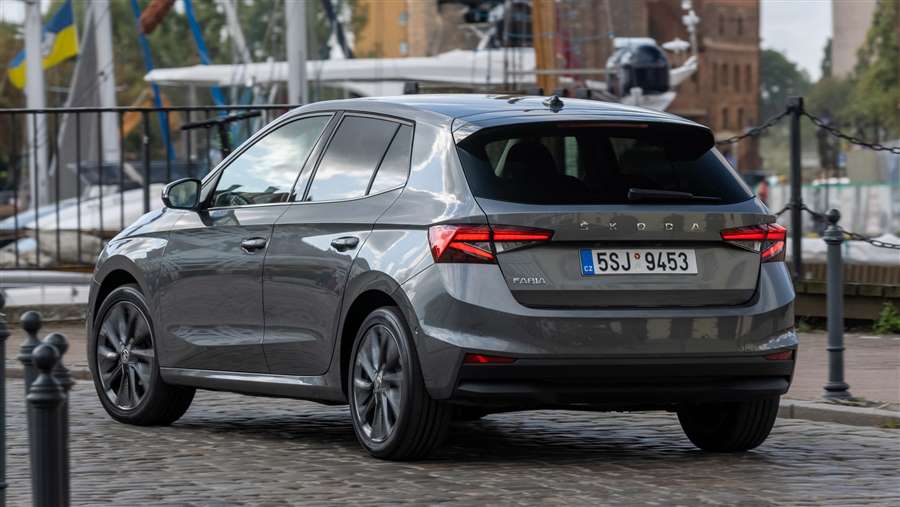
On the road, the Skoda quickly makes a strong case for being the most accomplished of all the VW Group superminis. The steering is direct and nicely weighted, and the suspension set-up is definitely softer than in the likes of the SEAT Ibiza, so even with its relatively simple layout - MacPherson struts at the front, and a torsion beam at the rear - the Fabia does a great job of dialling out bumps and potholes, particularly at lower speeds around town.
The compromise is body control that can get out of phase and require a second stab at mid-corner bumps, so the Skoda isn’t really a car that appreciates being thrown around at speed. But it’s comfortable and composed most of the time.
The engines are where the Fabia might find it toughest to fulfil family car duties. The 94bhp unit is refined enough once you’re up and running, but getting to that point requires some patience. There’s not much grunt at all below around 2,300rpm, and there’s a noticeable delay as it spools up before delivering the required shove. It’s acceptable around town, we’d say, but going anywhere in a rush with four occupants and luggage would require a little patience, along with tolerance of a fair bit of three-cylinder thrum.
The 108bhp is stronger all round, with a slightly quicker response and noticeably more punch when it does kick in. It’s happier at motorway cruising speeds too, aided by that extra ratio in the transmission, and we doubt it would really be much less efficient in real-world use. Given that any price gap between the pair is bound to narrow when boiled down to monthly PCP rates, we’d try to find the extra few quid per month for the more potent engine.
(autoexpress.co.uk)
What awaits us from Citroen by the end of 2022
The current year is in every sense very busy for the French Citroën. The company prepared several premieres in the first year of the world, so we saw the restyled C3 Aircross, a completely new model C5 X as well as the restyled C3-XR, which, however, will be enjoyed only by customers from the territory of the People's Republic of China.
However, the Gallic brand does not stop there, and the coming months will be full of new models and celebrations on the occasion of their presentation. The excitement has been going on since September, and we will follow what the French are preparing for us by the end of next year through this text.
Indeed, the first ceremony is scheduled for September 16, at which Citroen will present a version of the C3 model intended for the Indian subcontinent. That hatch will be a heavy burden of responsibility for establishing, reviving and strengthening the brand's popularity in India, as well as in Latin America, where it will be counted on as a "player that changes the course of (market) competition".
Citroën will then continue its efforts to improve sales, followed by presentations of the new C5 X range, when the audience will be introduced to the choice of powertrains, equipment packages and prices that the development team has planned to stick to the new sedan. After the premiere, Citroen plans to open order books, while the vehicle is expected in showrooms just before we get ready for the arrival of the New Year.
We are quite sure that our Perica Rajković will get the opportunity to test a new and completely unusual limousine from France, before the newcomer arrives at our showrooms, and having in mind his "good" relations with the manufacturer, which never lead to any income. We believe that the audience will be especially interested in Rajković's observations in the context of the operation of a system of controlled suspension called Advanced Comfort.
As for 2021, "citroen excitement" is over, but for new bursts of endorphins, fans will not wait further than February 2022, when Citroën will show the washed C5 Aircross. You can see the photo of the masked prototype above, and it appeared on the net a few days ago.
We will see this new C5 Aircross a couple of weeks before we welcome the premieres of the restyled Citroën Jumpy and Spacetourer models. These four-wheelers are expected to have a redesigned vehicle snout, as well as a center console with an emphasis on the instrument panel that should feel a touch of modernism, thus maintaining the demand for cars in the final phase of market life.
Thus, the mentioned two wrinkle tightening operations will precede one straight-line premiere. The novelty we are talking about is a special C4, whose code name is C43 and which will have its debut in April 2022.
This C43 will be just a variation of the C4 model, so it will be in the class, if it can be said at all, of a sedan made in China, but also in Spain. The Madrid factory will deal with it there, so it will be offered by the French brand on the Old Continent as well. With a length of about 4.6 meters, it will be an excellent alternative to the reference Škoda Octavia, which records excellent results across our dear continent.
The grand finale of the first half of 2022 will mark the arrival of the future European version of the urban toddler marked C3. Introduced in the month ahead, the C3 for the Indian and Brazilian markets should roll down the roads there before the end of the year, while it seems illogical that we in Europe will wait almost two more years for the same (as of this moment).
This doesn't make much sense because the French brand will have to rely heavily on electric car sales (including ë-C3, as sales of the ë-C4 and hybrid C5 Aircross will not be enough to enable Citroen to meet rigid emissions requirements. and it is not unreasonable to expect that, in the middle of 2022, the presented C3 will be in active supply even before the end of the next calendar year.
All this before the future C3 Aircross will be presented to those living in India and Brazil in September. The future C3 Aircross will be the second model of the Citroen program with an elevated seating position (the so-called C-cubed program), and will be based on the CMP architecture. This would mean that it will appear in a variant that offers accommodation for up to seven people, as well as that it will be offered in all world-important regions, which of course includes China and Europe. But this story will not unfold until 2023.
The end of the year will be marked by the promotion of the mentioned C43 model, which is an event scheduled for October in France, while the promotion of the C3 model should start in November. Alternatively, that moment could be postponed until January 2023, as we wrote above.
As we can see, after a very "dense" first half of the year, the news from Citroën will not be thinned out, even in the next few months, as there are more promotional events in the calendar. So, fromthese brands should be expected to respond to the current challenges they face, where the most complex is the attempt to succeed in India. In that sense, the formation of the mega company Stellantis is of essential importance, which would enable Citroen to take even more intense international sales results, all in the desire to reach the figure of 1.5 million deliveries, which is the goal set by the management for 2025.
2021 Dodge Durango GT First Test: Still Young at Heart
In its 11th year, the freshened Durango drives newer than some and tows more than all competitors.
This 2021 Dodge Durango GT seems a little like the older big kid in class who might have been held back a grade or two. Compared to his peers, he's more muscular, capable, mature. He'll never be valedictorian, but he's sure gonna get picked first for the tug-of-war team.
Gently Massaged
The third-generation Durango enters its 11th year with a freshened wardrobe (fascias, lights, spoiler, footwear), and a fancy 10.1-inch optional Uconnect 5 screen that's just as big, bright, and crisp as the calculators all those younger, scrawnier, smart-enough-to-skip-a-grade kids keep showing up to class with.
Given the advanced age of the 2021 Dodge Durango GT, the structure feels remarkably tight, absorbing road inputs without reverberation. Interior materials—even on this mid-grade example—also seem quite class-competitive, with stitching on the dash and armrests. It doesn't seem to want for much modern technology, either, with available wireless Android Auto and Apple CarPlay, over-the-air-upgradable infotainment, available wireless charging, a Wi-Fi hotspot, and a liberal sprinkling of A- and C-Type USB ports throughout the cabin. It feels notably newer than the 2018 Dodge Durango 4 R/T that spent a year in MotorTrend's Detroit office.

Tech Extras
If you want your 2021 Dodge Durango to have key items like advanced brake-assist, forward-collision warning, and adaptive cruise control, they come bundled in a Technology Group option on most trim levels. It added $2,495 to this Durango GT model, it's not offered at all on the base SXT, and it's only included as standard equipment on the Citadel model. Yes, you must pay $2,395 for adaptive cruise even on the Durango SRT 392 and Hellcat.
Sadly, no matter how hard this big-boy studies, he's just never going to ace the crash tests invented after he started school, so the Insurance Institute for Highway Safety (IIHS) rates the Durango "marginal" on the small-overlap test. (Deficient structure and safety-cage performance resulted in poor lower-leg-/foot-injury-rating performance.) The National Highway Traffic Safety Administration (NHTSA) rates it four out of five stars in all but side impact (5/5).
Still Some Reasons To Buy
For these reasons and more, our MotorTrend Ultimate Car Rankings place the Dodge Durango toward the back of the three-row SUV class, but that doesn't mean it's not the ideal vehicle for certain buyers. Any Durango might be an obvious choice if you occasionally need to tow a 6,200-8,700-pound trailer but don't care to deal with the bulk, cost, and/or fuel economy of a full-size Chevrolet Tahoe, Ford Expedition, Nissan Armada, or Toyota Sequoia. The rest of the mid-size three-row class tops out at between 3,500 and 5,000 pounds, with the Ford Explorer rated next best at 5,300.

Put To The Test
But then, sporty is as sporty does, and all the structure and size required to make the 2021 Dodge Durango GT a great tow vehicle add a lot of weight relative to its classmates. The fact its aging 3.6-liter Pentastar V-6 ranks mid-pack in terms of power and torque helps land the AWD V-6 Durango a lowest-in-class performance of 7.8 seconds to 60 mph and 15.9 seconds through the quarter mile at 88.5 mph. The rear-wheel-drive model shaves but a tenth or two off those times without surpassing any other AWD competitors. Of course, stepping up to the first of the Dodge Durango's three V-8 options in an R/T model bumps it to near the front of the pack behind the lighter Ford Explorer ST and Honda Pilot Black Edition. In fact, the bigger-engine SRT models legitimately compete with fancy-brand Euro SUVs.
It's the same story with handling performance, where the V-6-powered 2021 Dodge Durango GT laid down figure-eight and maximum lateral-grip figures that largely trail the class, while the R/T ranks well and the SRTs are in another class entirely. But can we agree that folks in the market for a mainstream three-row SUVs don't plan on using them for bracket racing, gymkhana, or to burn up the Tail of the Dragon?

Beyond The Numbers
When those buyers aren't towing boats and campers on the weekend, they just want to haul people and stuff in quiet comfort. Here again, sadly, the basic 2021 Dodge Durango GT makes a less compelling case for itself. In terms of both overall cargo space with all seats folded, and third-row passenger volume, Durango ranks smack in the middle of the class. But tallying total passenger volume in each seating row plus cargo room behind the third-row seat, its 158.8 total cubic feet bests only the Toyota Highlander, GMC Acadia, and Mazda CX-9.
The newer kids are also getting mighty clever with things like third-row seat access. The forthcoming Jeep Grand Cherokee L and Nissan Pathfinder, for example, each allow the middle-row seat to tilt and slide forward while an empty forward-facing child seat remains installed. The Durango's middle-row seats, on the other hand, require the backrest to fold before dumping the entire seat forward for third-row access. Even if your family has outgrown child seats, the new way is easier—particularly with Nissan's electric actuator buttons.

Bottom line: If you don't tow anything and don't much care what your family-schlepper looks like, the SUVs at the top of our rankings list may offer better overall utility, superior safety, and lower ownership costs. But among the cool kids, this big, brash 2021 Dodge Durango GT is destined to win popularity contests.
(motortrend.com)
The new Lamborghini Countach is officially unveiled
It is a limited production hypercar that pays homage to the legendary model from the past, which has just celebrated its 50th anniversary. In essence, the new model with the designation LPI 800-4 adopts the design elements of the cult predecessor with the modern technology Siana FKP 37, which is based on the Aventador.
Like all modern supercars with a bull badge, the LPI 800-4 retains its wedge shape, angular surfaces and specific doors. Interestingly, all of these design solutions also had a prototype Countach LP500 designed by Marcello Gandini in 1971. Three years later, the serial Countach with the LP400 label debuted.
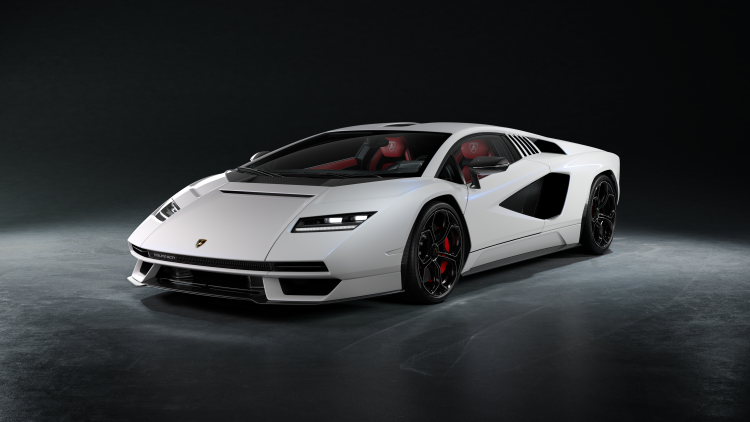
On the front, the most prominent are the trapezoidal lights, the straight nose and the rectangular suction cups, which are reminiscent of the later version of Countach from 1985. The wheel arches have a retro hexagonal shape, and inside them are placed wheels 20 inches in front, and 21 inches behind.
Elements of the 1971 prototype can also be seen behind the slit-shaped side windows, the perscopio roof design and the rear windscreen. On the other hand, elements such as a huge air duct and upper suction cups on wide "shoulders" are more reminiscent of later versions from the late 80's.
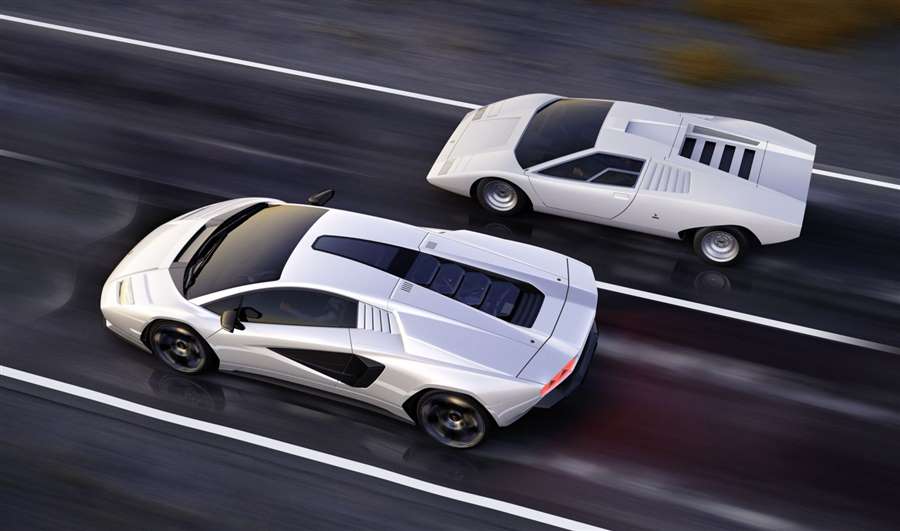
The hexagonal taillights are borrowed from the Sian, but the rest of the rear uses a simpler approach with an integrated carbon fiber diffuser with a quadruple exhaust end. There is no visible rear spoiler, but the lines suggest an active spoiler, although Lamborghini did not reveal anything about active aerodynamics.
In addition to the carbon fiber monocoque, the LPI 800-4 with the Sian also shares an atmospheric 6.5-liter V12 with hybrid technology. It produces 780 hp in the new Countach, while the 48-volt electric motor generates an additional 34 hp.
According to the Auto Club, power is transmitted via a seven-speed automatic to all four wheels. As in Xi'an, the energy from the regenerative braking system is stored in a supercapacitor that is lighter than a classic lithium-ion battery.
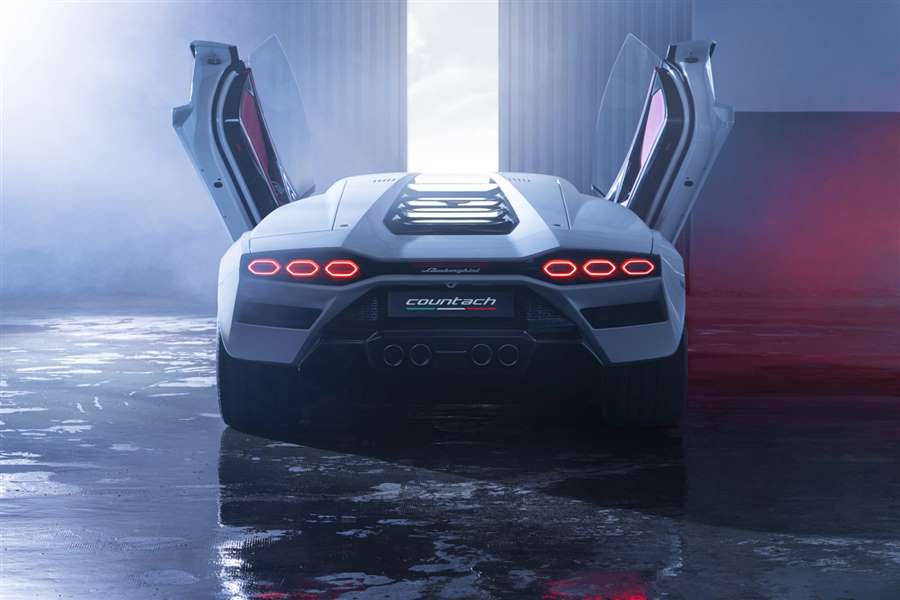
From Lamborghini, they announce acceleration to 100 km / h in 2.8 seconds, from 0-200 km / h in 8.6 seconds and a top speed of 355 km / h. These are the same performances that Sian FKP 37 and Aventador LP 780-4 Ultimae have.
The Countach LPI 800-4 is presented with a red and black leather interior, however Lamborghini points out that every customer will be able to choose between four traditional exterior colors and four interior configurations.
As it was announced, a total of only 112 copies will be produced. Prices have not been revealed, but the LPI 800-4 should be positioned between Aventador and Siano FKP 37. The first deliveries are expected early next year.
2023 Porsche 718 Cayman GT4 RS Is the One We've Been Waiting For
Take the already excellent 718 Cayman GT4, give it more power and performance, and drive to the edge.
WHAT IT IS: An even more capable, focused, and track-ready version of Porsche's already magical 718 Cayman GT4.
WHY IT MATTERS: From the moment Porsche launched the original Cayman for the 2006 model year, the car was lauded as a great choice for enthusiast drivers. Simultaneously, more than a few people wondered what an uncorked Cayman could do if Porsche would only give it the power and performance hardware reserved for the 911. As years passed, Stuttgart began upping the Cayman's game, releasing models such as the Cayman R, the GTS, and finally the GT4. Now, the 718 Cayman GT4 RS takes another leap by receiving upgrades reserved previously for hardcore versions of the 911 GT3. The result should not only boost the driving fun of what is already a brain-meltingly great sports car but also lift the Cayman's overall image in the eyes of track-day addicts looking for a new hot toy to flog.

PLATFORM AND POWERTRAINS: The standard Porsche 718 Cayman GT4 is one of the most impressive drivers' cars on the market, with spectacularly high limits that beg to be explored on racetracks. The Cayman GT4 RS will likely get the same sort of GT treatment Porsche consistently gives to its 911 GT3 RS big brother. That means less weight, more aerodynamic performance and grip thanks to a larger wing and more aggressive bodywork, an even more capable suspension, and yes, more power.
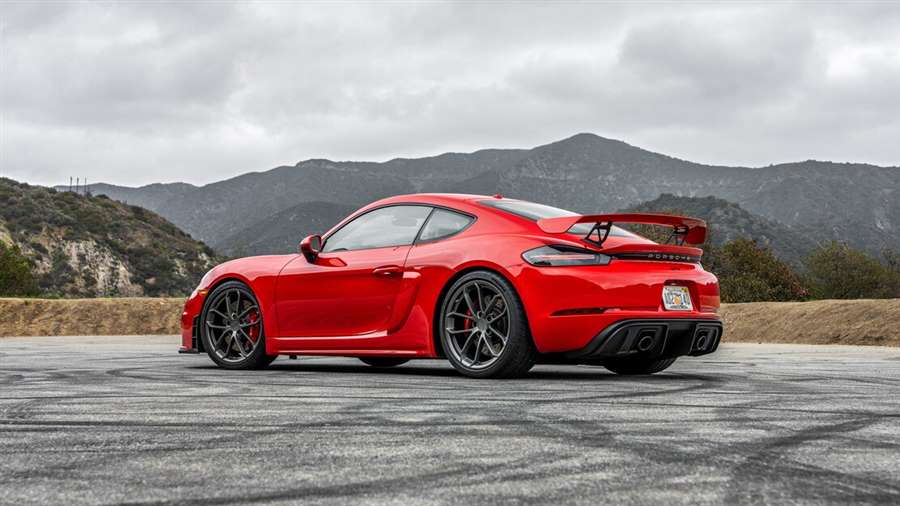
The standard GT4's naturally aspirated flat-six delivers 414 hp and 309 lb-ft of torque, and it seems unlikely Porsche can squeeze much more output from that particular 4.0-liter boxer. We won't be surprised if the GT4 RS gets a 20-plus-horsepower bump courtesy of a new naturally aspirated six-cylinder, and logic says the engine could very well be a detuned version of the 502-hp 4.0-liter featured in the latest 911 GT3. As for the transmission, modern RS models have been equipped only with Porsche's PDK dual-clutch gearbox, a trend that seems likely to continue here.
(motortrend.com)
This is a fantastic Dodge Charger from the movie Fast 9 (GALLERY)
It has been several months since the ninth part of the "Fast & Furious" film series arrived in cinemas, but for some reason very little has been said about it. Perhaps many are tired of waiting for him, since the Prime Minister was a year late due to the epidemic of the corona virus, and hand on heart, both the story and the acting are relatively bad.
Far from expecting anything special, however, even by the standards of "Fast & Furious" movies, acting is below average (especially by John Sina), and action scenes are funnier and more unrealistic than ever (although they are still very professionally done).
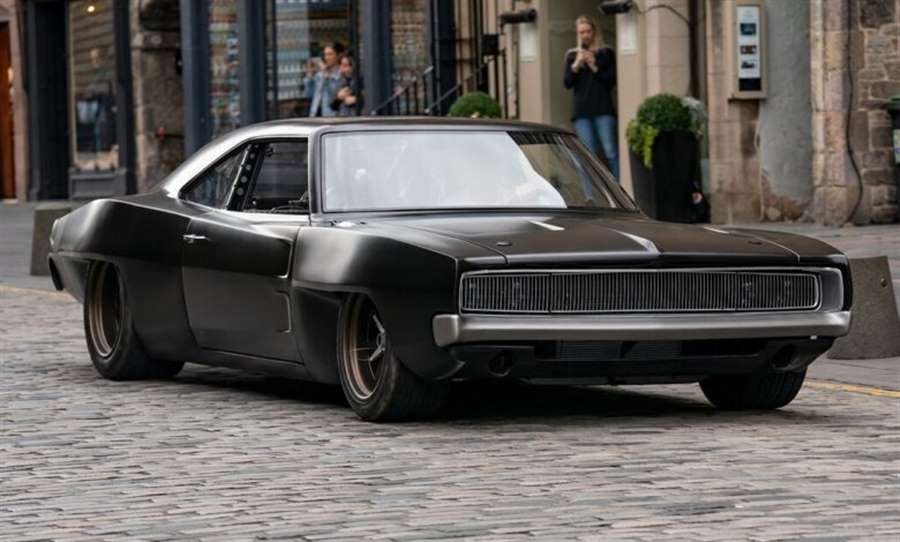
But at least for a moment we will forget about all the criticism and concentrate on one fantastic car that appears on small screens. It is about a 1968 Dodge Charger that the character Dominique Toreto (played by Vin Diesel) drives in several scenes. He is an extremely popular representative of the American classic "muscular" school, which is worth a lot of money today, and the author of this story, although a Ford at heart, will tell you that Charger is the most legendary "muscle car". However, this particular model differs in that it provides a modern Hellcat engine and it is placed centrally. At first glance, it is easy to conclude that the rear of the vehicle is the so-called "wide-body", and when you look under the rear window, you will understand why.
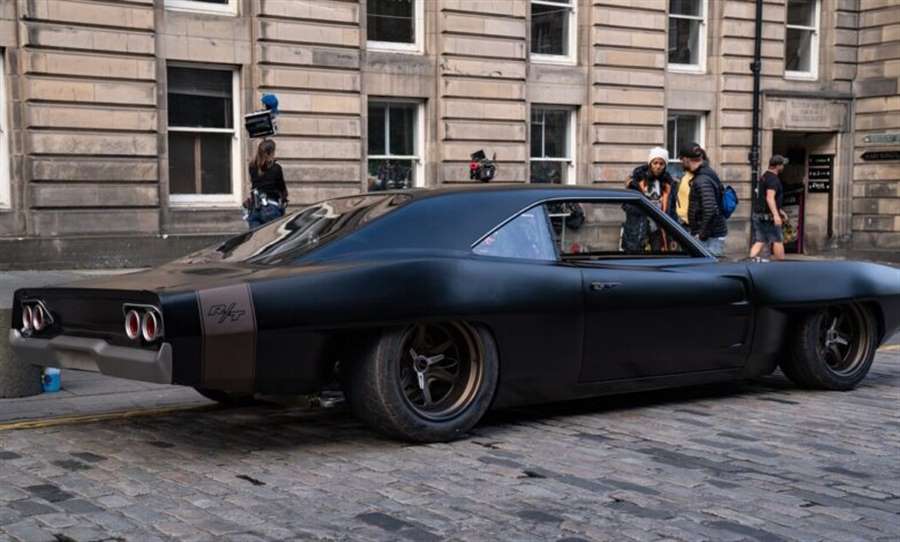
The company Vehicle Effects took care of its production, and he says that nine copies were made for the needs of the film. However, only two were functional models with Hellcat engines, while the rest were destroyed in various crash scenes. They were actually just a shell on a chassis and a plastic engine to get film magic as they perished in various chases. But the scene where Dominic drives a Charger in Scotland is a true functional model with over 800 horsepower while a six-speed manual transmission is taken from Lamborghini’s Gallard.

With such a configuration, this Dodge has undergone many more modifications. The chassis was taken care of by the company SpeedKore Performance, the exhaust system is the work of Magnaflow, and Vehicle Effects, which is otherwise engaged in the production of all cars for "Fast and Furious" movies, finally put it into final work. The biggest problem was certainly to fit the wider rear of the vehicle to make it look as fantastic as the production model and we can conclude that the tuner did a fantastic job.
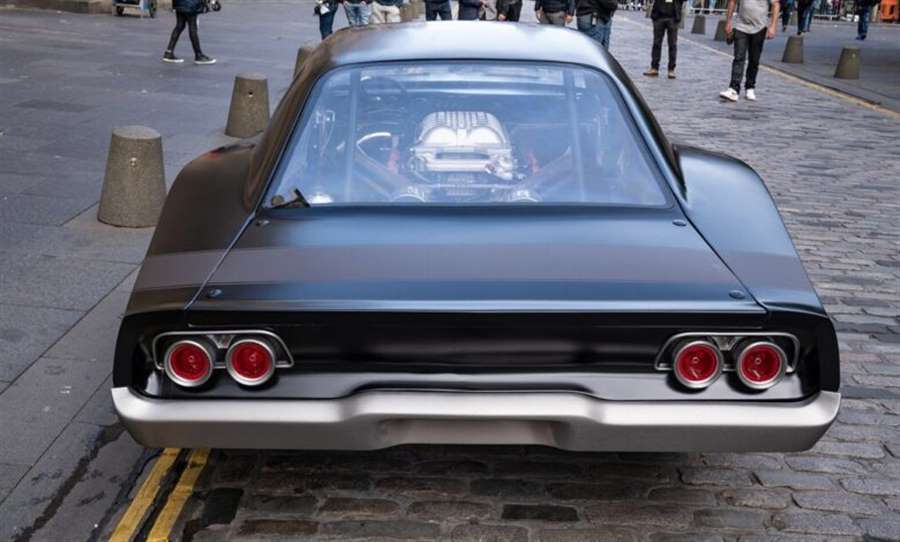
Vehicle Effects says they’ve seen a lot of Chargers with over a thousand “horses,” but this one is really special, and a similar model used by one of the employees at SEMA, held every year in Las Vegas, was used for inspiration. Each copy took about four months to complete.
We hope that the two originals ended up in private hands and that we will have the opportunity to see them in the future as well. And as it is known, the production company announced two more parts of "Fast & Furious" before the end of the series, so it remains to be seen what kind of masterpiece Vehicle Effects will prepare for us in the future.

